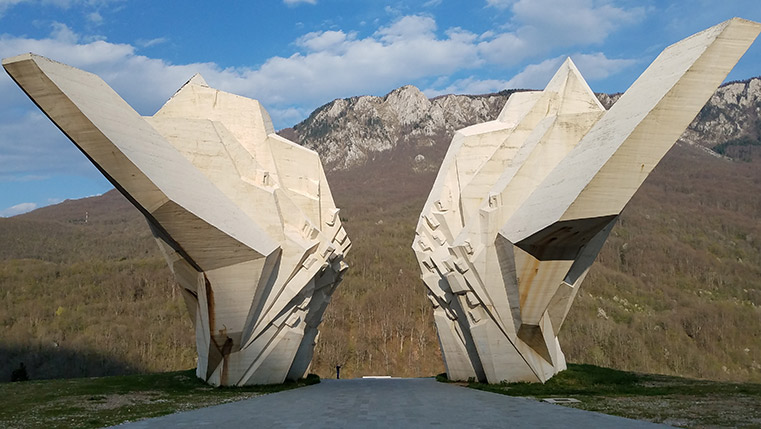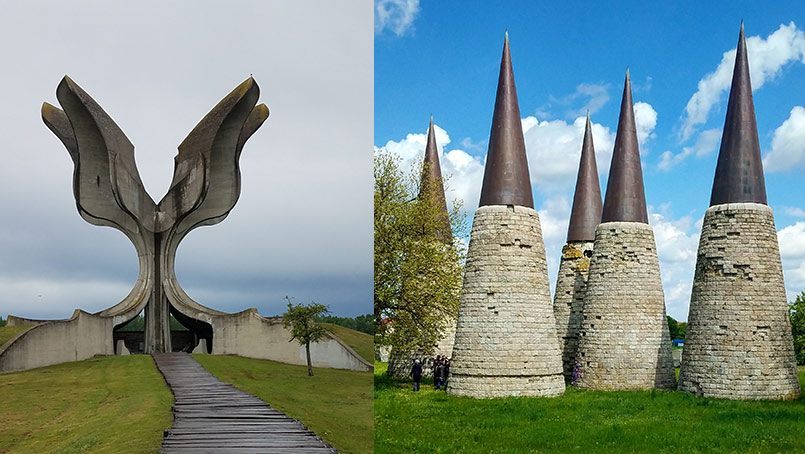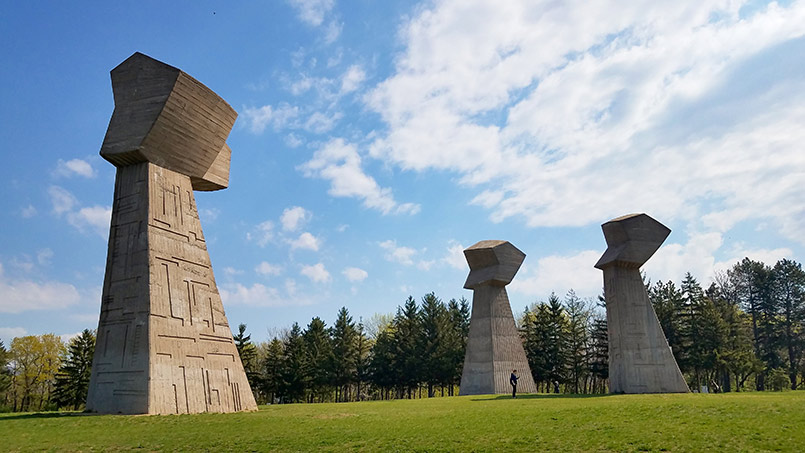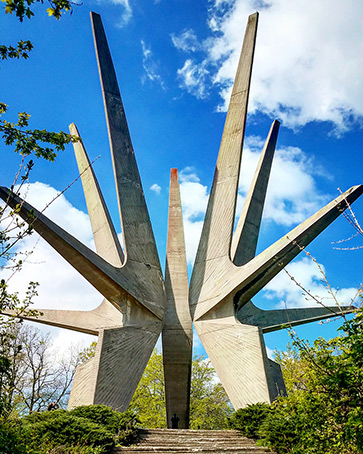
23 May Memory, Politics and the Art of Commemoration
Throughout the cities, hills and mountains of the former Yugoslavia, vast Modernist monuments recall the heroism of anti-fascist Partisans and revolutionaries. Once upon a time, these striking sites were busy with tour buses and school children, but ever since the collapse of Yugoslavia, the visitors have dwindled. On a recent trip to Serbia, Bosnia and Croatia, HBI’s Executive Director, Kathy Kottaridis visited a few of these enormous stone and concrete structures to learn more about their creation and meaning.
The modern countries that once made up Yugoslavia have inherited monumental buildings, landscapes and art installations that commemorate places significant to the fight against fascism during World War II. Most of these so-called “Spomeniks” mark places of overwhelming horror inflicted on civilian and military groups by the Nazi and Axis’ occupation between 1941- 1944. Powerful memories and profound losses were an important motivation for the commission and design of these monuments, but so was the need to forge a new Yugoslavian identity after the war under the banner of socialism by the revolutionary statesman, Josip Broz Tito.
Tito commissioned numerous national monuments at sites marking battlefields, concentration camps and places of mass executions. They were meant to give patriotic unity to the young Yugoslavia and, as such, were the focal point for massive gatherings for partisan veterans and school children. At the same time, their development fostered a generation of extraordinary modernist architects, sculptors and designers.
My recent 10-day study tour of Spomeniks in Serbia, Bosnia and Croatia was a crash course in Balkan history through the lens of mid-century expressive art. It was also an awakening to art’s vulnerability to changes in political power and perceptions of patriotism over time. Here are the stories of a few of these unusual monuments:

(Left) Jasenovac Memorial (Right) Dudik Memorial Park
Jasenovac Memorial, Croatia, 1966, by Bogdan Bogdanovi?
Known as the ‘Flower’ monument, this site memorializes the hundreds of thousands of Serbs, Jews and Roma executed at the notorious Jasenovac forced labor and extermination camp run by the Independent State of Croatia’s Nazi-aligned Ustaše forces. The monument was dedicated in 1966 and is one of the world’s most recognized commemorations of genocide.
Dudik Memorial Park, Vukovar, Croatia, 1981, by Bogdan Bogdanovi?
An estimated 455 civilians were executed by Croatian Ustaše forces at the site of this memorial between 1941 and 1943. It was dedicated in 1980 after two years of construction. The conical structures are set within the grove of mulberry trees where the mass graves of those killed were found. Adjacent to cone structures are 27 stone blocks that are shaped like boats and, like many of Bogdanovic’s commemorative works, are laid out randomly.

Bubanj Memorial Park, “The Three Fists” Niš, Serbia, 1963, by Ivan Saboli? and Mihajlo Mitroci?
The monument of the Three Fists marks the place where more than 10,000 Serbian, Jewish, and Roma people were executed from 1942 until 1944 by the Nazis. The open lawn on which the large concrete structure sits is filled with trenches where those killed were buried. Unveiled in 1963, the monolithic fists are framed by an amphitheater and a marble wall sculpture that tells the story of the site.

Kosmaj (Monument to the Fallen Soldiers of the Kosmaj Detachment), Kosmaj Mountain Park, Serbia, 1971 by Vojin Stoji? and Gradimir Medakovi?
Unveiled in 1971, this monument commemorates the Partisan regiment of residents from the surrounding area who fought the Nazi forces occupying Serbia. The central monument is a set of five concrete pieces that, assembled together, resemble a star. The monument is located in a large verdant park, and to reach it, visitors must climb a grand staircase from the road below.

The Battle of Sutjeska Memorial in the Valley of Heroes, Tjentište, Republic of Srpska, Bosnia & Herzegovina, 1971, by Miodrag Živkovi? and Ranko Radovi?
This monument honors the 7543 Yugoslav soldiers lost at the Battle of Sutjeska that took place from May 15th to June 16th, 1943. It was a joint attack by the Axis forces which aimed to destroy the main Yugoslav Partisan force under the command of Josip Tito in south-eastern Bosnia. The failure of the Axis offensive marked a turning point for Yugoslavia during World War Two.
Dozens of monuments like these are located throughout the former Yugoslavia, but the geopolitical shifts of the late 20th and early 21st Balkans changed the fortunes of these art works and their stories. With Josip Tito’s death in 1980, Yugoslavia disassembled into multiple new nations, and it was not long before Tito’s united front further devolved into painful episodes of war and ethnic cleansing.
Many of the Spomeniks we observed have fallen victim to these political winds of change. Most no longer have visitors or patriotic events, at least not in the numbers of the Tito era. They have fallen victim to graffiti, vandalism, and general deterioration. Many of the sites we visited were also caught in the literal crossfire of the Yugoslav Wars of the 1990s, and are riveted with bullet holes or crumbling from artillery hits. During the Battle and Seige of Vukovar, roughly 90 % of the city was destroyed by the Serbian Yugoslav People’s Army, and more than 1000 residents were killed. In that 87-day siege, Vukovar’s Dudik Memorial was seriously damaged by artillery and has only recently been partially repaired.
There is burgeoning interest in the Spomeniks that parallels a general interest in the preservation of mid-century modern architecture and design. If change is inevitable, then the burgeoning interest in the art and architecture of this time and these places, domestically and internationally, may shed new light on them and generate the resources and management necessary to repair and re-interpret them for new generations of visitors.



